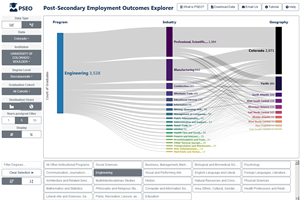end of header
Longitudinal Employer-Household Dynamics
Post-Secondary Employment Outcomes (PSEO)
|
Post-Secondary Employment Outcomes (PSEO) are experimental tabulations developed by researchers at the U.S. Census Bureau. PSEO data provide earnings and employment outcomes for college and university graduates by degree level, degree major, post-secondary institution, and state of institution. These statistics are generated by matching university transcript data with a national database of jobs, using state-of-the-art confidentiality protection mechanisms to protect the underlying data. The PSEO are made possible through data sharing partnerships between universities, university systems, State Departments of Education, State Labor Market Information offices, and the U.S. Census Bureau. PSEO data are available for post-secondary institutions whose transcript data have been made available to the Census Bureau through a data-sharing agreement. |

|
||||
Download Public-Use DataWe release two classes of files for each of the tabulations, Graduate Earnings and Employment Flows:
Data files are provided in zipped CSV and XLS formats and can be downloaded below. The XLS files have variable labels attached, but do not include all the possible rows from Employment Flows, due to size constraints.
PSEO data can also be accessed via the
PSEO Explorer visualization tool. This interactive tool allows for comparisons of employment outcomes through dynamic grouped bar charts and employment flows through Sankey diagrams.
To browse PSEO data files, go to: lehd.ces.census.gov/data/pseo/.
Column definitions and other important information can be found in the schema files located in: lehd.ces.census.gov/data/schema/latest/lehd_public_use_schema.html. Examples of how to access and visualize PSEO raw data files using open source programming
languages can be found here: lehd.ces.census.gov/data/lehd-code-samples/sections/pseo.html.
|
|
| State | Data Partners | Share of State Graduates |
|---|---|---|
| Alabama | University of Alabama System | 21% |
| Arizona | Arizona Board of Regents | 25% |
| Colorado | Colorado Department of Higher Education | 72% |
| Connecticut | Connecticut Conference of Independent Colleges Connecticut State Colleges and Universities University of Connecticut | 69% |
| District of Columbia | University of the District of Columbia | 3% |
| Georgia | Georgia Independent College Association University System of Georgia | 43% |
| Hawaii | University of Hawaii System | 72% |
| Illinois | Illinois Board of Higher Education Illinois Community College Board | 69% |
| Indiana | Indiana Commission for Higher Education | 77% |
| Iowa | Iowa Board of Regents Iowa Department of Education | 66% |
| Louisiana | Louisiana Board of Regents | 74% |
| Maine | Maine Community College System University of Maine System | 54% |
| Massachusetts | Massachusetts Department of Higher Education | 32% |
| Michigan | Institute for Research on Innovation and Science (University of Michigan - Ann Arbor) | 10% |
| Minnesota | Minnesota Office of Higher Education | 74% |
| Missouri | Missouri Department of Higher Education and Workforce Development | 50% |
| Montana | Montana University System | 83% |
| New York | The City University of New York The State University of New York | 44% |
| Ohio | Ohio Department of Higher Education | 61% |
| Oklahoma | Oklahoma State Regents for Higher Education | 66% |
| Oregon | Oregon Higher Education Coordinating Commission | 70% |
| Pennsylvania | The Pennsylvania State University | 11% |
| Rhode Island | Bryant University Providence College | 10% |
| South Carolina | South Carolina Commission on Higher Education | 86% |
| South Dakota | South Dakota Board of Regents South Dakota Board of Technical Education | 80% |
| Texas | Texas Higher Education Coordinating Board University of Texas System | 77% |
| Utah | Utah System of Higher Education | 73% |
| Virginia | State Council of Higher Education for Virginia | 87% |
| West Virginia | West Virginia Higher Education Policy Commission | 43% |
| Wisconsin | Institute for Research on Innovation and Science (University of Wisconsin - Madison) University of Wisconsin System | 45% |
| Wyoming | University of Wyoming Wyoming Community College Commission | 86% |
| Online-Only | Western Governors University | -- |
| * Note: Coverage based on the share of public and private graduates sourced from 2015 Completions Data from IPEDS. University of Phoenix is omitted from the graduate count for Arizona because most graduates are engaged in distance learning. |
Comments or suggestions?





